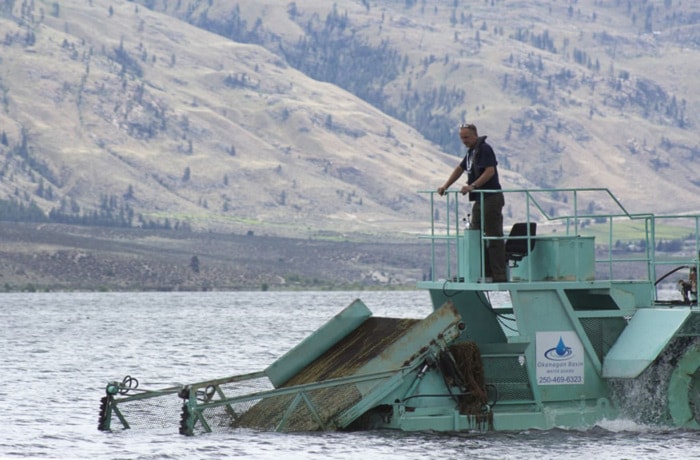Just as tourists start to flood into the Okanagan for the start of beach season the invasive aquatic weed, Eurasian Watermilfoil, has decided to make an early appearance in valley lakes.
“This year, the combination of the early snow melt and the record warm temperatures seem to have created perfect conditions for the milfoil to grow early,” said James Littley, operations and grants manager for the OBWB.
“We spent extra time on the water over the winter trying to get ahead of the summer growing season, but we just can’t compete with the changing climate.”
Usually the water board is just starting to survey the lakes to see where the milfoil is growing under the water and where they need to start working. This year they received their first call last week about the weeds and then today I had a couple calls saying the weed had broken the surface of the lake and is starting to form mats. It is looking like a good year for milfoil, and that’s bad for the rest of us.
In summer 1972, the provincial government partnered with the Water Board and started an intensive program to remove the newly introduced, invasive milfoil from Okanagan lakes.
The early goal was eradication by any means necessary — trying chemicals, bottom-barriers, dredging, and hand-pulling. The program was handed over to the Water Board in 1998 and more recent control efforts have included research into breeding special weevils to eat the weed.
Today, the Water Board employs three operators who spend 1000s of hours on the water every year to control the volume of the invader at our beaches, boat launches and marinas, at over 200 sites in the valley.
Uncontrolled milfoil has negative effects on tourism, and studies have shown that thick milfoil mats can lower lakefront property values by as much as 19 per cent, said Littley.
Environmentally, milfoil robs oxygen from the water, increases water temperature, slows the flow at the mouths of rivers, and increases polluting nutrients in the water. It has also been linked to fish kills and loss of biodiversity. Just last year, a provincial study found the primary factor reducing the flow of Okanagan River out of Vaseaux Lake was milfoil growth.
Most milfoil in Okanagan lakes is controlled. Wood, Kalamalka, Okanagan, Skaha and Osoyoos all receive regular milfoil treatment through the OBWB program. In the winter, milfoil operators rototill the weed while it’s dormant. The roots are then left to freeze and die. In the summer, the weed is mowed six feet below the surface and collected, then trucked to local gardens and orchards for fertilizer.
The program takes into account fish and other species habitats, spawning seasons, sensitive plants, at-risk animals, and special events like triathlons. Today the OBWB’s work is guided by electronic maps and tracked with GPS. Staff use non-toxic lubricants, and have up-to-date safety equipment and protocols.
“We’ve come a long way from pitch forks and scythes,” said Littley.
“Still, the program faces challenges, and in some ways, we’re victims of our own success. If we do a good job, no one thinks milfoil is a problem. But, as recently as last summer our equipment was robbed and vandalized. We compete on the water and at boat launches for space with other boaters, sometimes leading to abusive comments to our operators. Increasing development along the waterfronts can make some of our equipment loading sites inaccessible, restricting operations and lessening efficiency. And of course, we still deal with breakdowns, frozen lakes, sick days, and the sheer volume and area of milfoil growth that we try to control.
For more on the OBWB’s Milfoil Control Program, visit www.obwb.ca/milfoil. Also www.okwaterwise.ca/nature. For more on invasive mussels and the risks to the Okanagan, visit www.DontMoveAMussel.ca.
